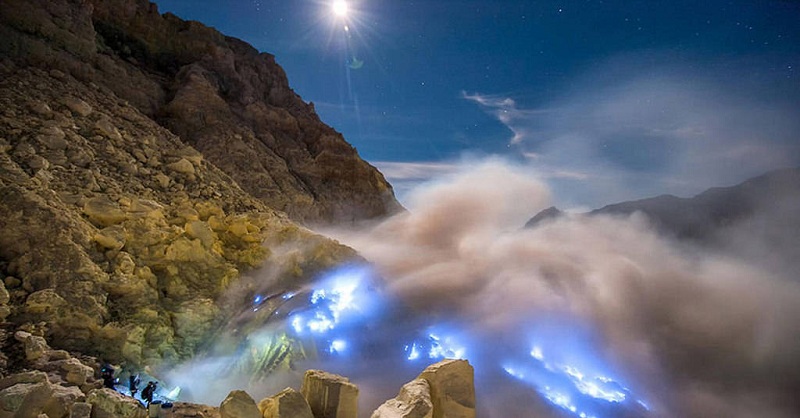Ijen Crater Blue Fire is an extraordinary natural spectacle, a sight of stunning beauty that draws visitors from across the globe. This unique geological event is part of the charm of Mount Ijen, an active stratovolcano nestled in the serene highlands of East Java, Indonesia. Renowned for its breathtaking scenery, Mount Ijen, or Kawah Ijen, has risen to popularity as a must-visit destination for its rare “Blue Fire” phenomenon, a wonder only found in one other place in the world: Iceland.

yukbanyuwangi.co.id
The Phenomenon of Ijen Crater Blue Fire
The captivating Blue Fire isn’t lava, but it rather the result of burning sulfuric gas. Highly pressurized sulfuric gases emerge from the volcano’s fissures at high temperatures, some reaching up to 600°C (1,112°F). When these gases make contact with the oxygen-rich air, they instantly ignite, releasing a luminous blue flame.
This phenomenon is most vivid in the darkness before dawn, painting the crater with an ethereal, otherworldly glow. The magnificent sight of the Ijen Crater’s blue fire cascading down the slopes is what makes the long trek to the crater edge so rewarding.
The Majestic Ijen Crater Lake
Beyond the stunning blue flames, Kawah Ijen boasts an enormous, striking crater lake. Spanning approximately 5,466 hectares, the lake is known for its intense turquoise-green color. This vast body of water is highly acidic, one of the most acidic lakes globally, with a depth that plunges up to 200 meters. The immense crater itself is a natural caldera, formed by a colossal ancient eruption of Mount Ijen. Despite being classified as a quiet volcano, Ijen remains active, underscoring the raw power of nature that exists here.
Location and Access
The Ijen highlands are a part of three regencies in East Java, Situbondo, Bondowoso, and Banyuwangi. However, the primary entry point for travelers is through Paltuding, located in the Banyuwangi region. While access is possible from Bondowoso, starting the journey from Banyuwangi generally offers a shorter route to the crater. The road is often winding, steep, and can be challenging, which is why hiring an experienced local guide is highly recommended to ensure a safe and smooth journey to the base camp.
The Trekking Experience
Witnessing the Blue Fire and the crater lake requires a dedicated hike. The ascent typically begins at the Paltuding post, which serves as the first base for the climb. The journey of Ijen Crater blue fire involves a challenging trek through a winding forest path up the slopes of the mountain. From Paltuding, the hike to the crater rim usually takes about two to four hours, depending on one’s pace and fitness level. Following this, an additional one to one and a half hours may be needed to reach the viewing point for the Blue Fire.
Due to the high altitude and pre-dawn timing, the climate is quite cold, necessitating the proper preparation of warm clothing. Although the trail to Ijen is notably wide and open compared to other mountain trails, caution is still essential during the climb. For safety and navigation, especially in the dark, visitors often hire a guide.
Facilities and Visitor Information
Ijen Crater has gradually developed facilities to support tourism. Around the entrance, small eateries serve local food and drinks, providing comfort before or after the hike. Basic amenities such as toilets, parking areas, and local transport services are also available. In addition, masks can be rented to protect against sulfur fumes, which are sometimes strong near the crater.
For ticket prices, domestic visitors pay around IDR 5,000-7,500 on weekdays and weekends, while international visitors are charged IDR 100,000-150,000. Considering the rarity of the spectacle, this fee is relatively affordable for such a world-class natural attraction.
The Ijen Crater Blue Fire offers a profound and unforgettable travel experience. It represents a harmonious blend of geological wonder and stunning natural beauty. The challenge of the trek is amply rewarded by the mesmerizing sight of the blue flames, a phenomenon that truly sets this destination apart. Along with the striking turquoise crater lake, Mount Ijen stands as a testament to the spectacular power and unique artistry of the natural world.